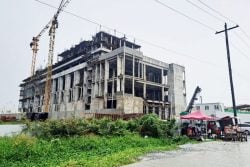Long considered a sector that could play a pivotal role in the advancement of a Guyana economy that had always been harnessed by resource restraint considerations, Guyana, on account of the opportunity arising out of its relatively new found oil and gas resources, is beginning, seemingly, to fit tourism into the country’s development matrix. Even a casual audit of the country’s tourism-friendly resources, not least its vast and decidedly visitor-friendly hinterland, makes a compelling case for fashioning a tourism ‘paradise’ out of the existing still largely unexplored hinterland.
Over the decades an absence of material resources with which to finance the protracted upkeep of a tourism industry has always remained a ‘big ask’ for a patently under-resourced Guyana. The proverbial worm, these days, is turning at a greater speed than might have been envisaged. Particularly, the resources with which to transform the natural and largely inhospitable environment into what we loosely (and to some, inappropriately) describe as a tourism haven are now within the country’s reach.
Oil, it seems, is set to be a game-changer, its announced discoveries offshore Guyana, beginning in 2015, creating a tsunami of national euphoria that rivalled, if not surpassed the jubilation associated with the realization of political independence almost two decades earlier. The intensity of the national jubilation that greeted the earliest confirmed oil find may have dampened down somewhat, still, the notion of oil as a game-changer remains ever present in the national psyche. Oil is seen, these days, as a game-changer, a transformational instrument.
If, however, the attractions which partially comprise the requisites of a successful tourism industry manifestly exist in Guyana, the expectations of the contemporary tourist have gone beyond the sun, sand and sea that had hitherto been applied in the Caribbean. These days, in the case of Guyana, a convivial tourism experience derives from both the satisfaction of wildlife-engineered hinterland experience as well as from a coastal/urban inventory that includes, of necessity, up market accommodation, suitably tasteful and appealing night life, novel and appealing cuisine and at least an urban environment where the safety of the visitor is not the sort of issue that the authorities need sweat over. If these requisites are in place then we might even make an argument for Guyana being one of the more convivial tourist spaces in the world. As it happens, we are, in the aforementioned respects, as yet not even remotely there.
That said, the potential, unquestionably, is there. Perhaps more pertinent is the fact that these days, the country is in an infinitely better position, materially that is, to create a world class tourism industry. Truth be told, there is no reason why the country cannot rise to the occasion. The current ‘buzz’ about a tourism industry is part of the wider promotion of a country that is ‘going places,’ the engine on which it is travelling being the country’s considerable resources. For that reason, alone, Guyana has become a place to see for investors (their frequent visits being more than sufficient for the country to present a pleasing visitor profile) who currently regard the country as the foremost investment haven in the region and are now showing clear signs of responsiveness to that circumstance.
At the levels of both the public and private sectors there is evidence of a focus on creating the infrastructure necessary to support a pleasing all-round visitor experience. In the instance of the private sector the creation of new Hotels, Guest Houses and various other places of entertainment, these days, provide significant investment opportunities. Meanwhile the Ministry of Tourism, Industry and Commerce has finally placed itself in a position of prominence amongst the various state agencies through its focus on what has now become the aggressive promotion of tourism in the potentially lucrative markets of Europe, North America and further afield. Guyana, it is felt in some quarters, now sees itself as being in a position to challenge the region, perhaps even the hemisphere for a position of prominence in what, over the years, has been a sector that is yet to come close to delivering on its potential.
The problems here have always been located mostly, though not exclusively, in affordability. While the country’s tourism ‘offerings’ are widely believed to be among the more diverse in the Caribbean, the issue of affordability associated with the creation of an infrastructure that will attract visitors ‘in their numbers’ has always been an issue. More recently, while the advent of oil has ‘resurrected’ the national tourism discourse at the levels of both the public and private sectors, thoughts on a tourism takeoff must be considered in isolation from the issue of just how long (and at what cost) we are going to be properly ready for tourists.
There is evidence that both the government and the private sector have ‘caught on’ to the fact that this could be the country’s breakthrough opportunity to complement the region in providing a world class varied visitor experience. What appears to be in our favour is the fact that the country’s designated Ministry of Tourism, Industry and Commerce is beginning to ‘step out,’ to ‘bat’ for the portfolio through relevant gestures like paying high-profile visits to parts of the country deemed to be visitor friendly. Here, it seems, as well, that we are no longer hampered in our efforts to aggressively promote tourism globally, by the restraint of what was once a state-propagated position that ‘tagged’ tourism with an unfriendly ideologically driven logo. These days tourism is regarded as a bona fide economic sector possessed of the potential to both generate income as well as further positively promote Guyana in the international arena.
It falls to the country’s current Tourism, Industry and Commerce Minister Oneidge Walrond, along with the Guyana Tourism Authority (GTA) to make the best of the fact that the sector is almost certainly enjoying the most pleasing image in its history. Certainly, it is no longer stigmatized by its ‘visitor playground’ image in addition to which, the promotion of the sector as a lucrative money-earner is decidedly more pronounced than it had been even a handful of years ago. That apart, Guyana is rapidly drifting away from the stigma linked to unfavourable episodes in its political history.
At the level of the Ministry of Tourism and the Guyana Tourism much work has been done in recent times to seek to promote the country’s tourism-ready image, though the response in terms of significantly increased visitor arrivals (save and except for purposes of business is yet to manifest itself.) There is, however, these days, a Minister of Tourism who meaningfully ‘speaks for’ the tourism portfolio, her recent visit to the Essequibo underscoring the fact that at the policy level, building a tourism industry would appear to be ‘in the sights’ of the political administration.
Globally, an appetite for leisure-related pursuits would appear to have grown in tandem with a continually emergence among sections of the global population and a corresponding appetite for ‘feel good’ pursuits, not least, ‘soaking up’ new visitor experience. Here, there is an opportunity for Guyana, first, to begin to create a long-wished-for ‘world class’ tourism industry and after that to benefit from the returns from what is almost certainly be a lucrative tourism industry.




